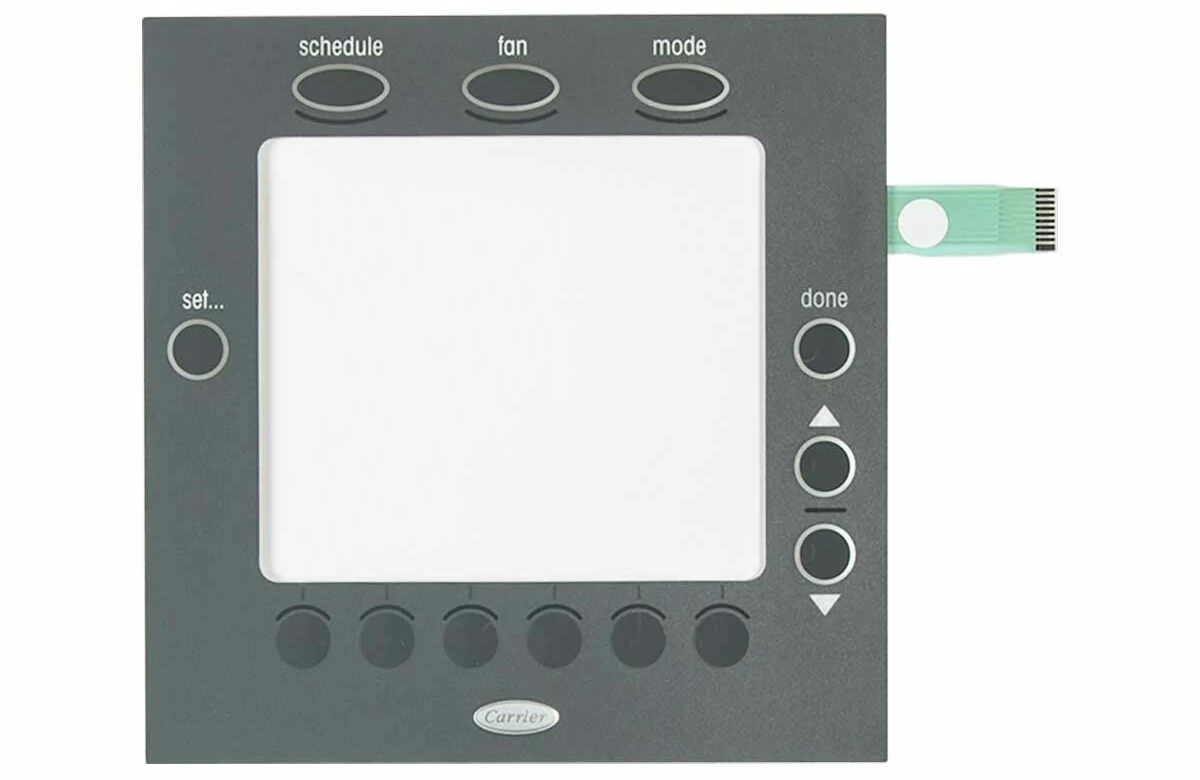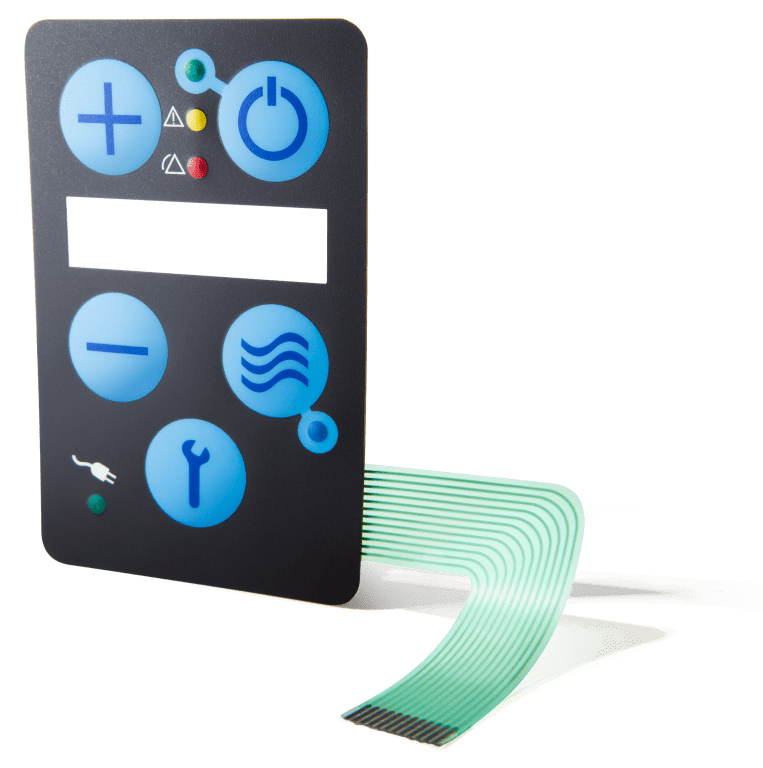Comprehending the Significance of Membrane Switches in Interface
Membrane switches are important elements in the design of efficient interface, facilitating not just functionality yet likewise enhancing visual appeal and customer interaction. Their one-of-a-kind functions, such as resistance to customizable layouts and environmental aspects, make them suitable for a varied array of applications throughout multiple markets. As we explore the different benefits and future patterns associated with Membrane innovation, it becomes clear that these buttons are greater than simply parts; they stand for a convergence of advancement and practicality. The effects of this modern technology on individual experience deserve examining further.
What Are Membrane Buttons?

The spacer layer, which includes sticky homes, enables the separation of the circuit layer from the overlay, ensuring that the button continues to be in a non-activated state up until pushed. When pressure is applied to the overlay, it compresses the spacer layer, linking the space and completing the circuit in the underlying layer. This design not just lowers the physical area required for traditional mechanical buttons however also enhances the longevity of the tool, as Membrane switches are usually resistant to dust, dampness, and other environmental variables.
Frequently found in applications varying from consumer electronics to clinical devices, Membrane switches are integral to modern-day technology, giving a effective and user-friendly interface that lines up with contemporary design demands.
Advantages of Membrane Switches
While countless switch modern technologies exist, Membrane Switches offer distinctive advantages that make them specifically desirable in different applications. One of the main advantages of Membrane buttons is their compact style, which enables space-saving applications in devices where property is restricted. Their thin account not just enhances visual allure but additionally facilitates light-weight construction.
One more substantial advantage is their resistance to environmental variables. Membrane switches are normally sealed against wetness, dirt, and contaminants, making them optimal for use popular environments, such as medical tools and commercial equipment. This toughness expands the lifespan of the switch, minimizing upkeep costs and enhancing dependability.
Additionally, Membrane buttons can be customized to meet particular style needs, including one-of-a-kind graphics and colors that enhance user interaction. Their tactile comments choices can likewise be customized to give an enjoyable user experience. Additionally, Membrane buttons are cost-effective, particularly in high-volume applications, as they can be produced efficiently.
Applications in Different Industries

In the consumer electronics field, Membrane switches prevail in gadgets such as microwaves, washing equipments, and push-button controls. Their tactile responses and visual options boost individual experience while offering a streamlined, contemporary look. In addition, automobile manufacturers use Membrane buttons in dashboard controls and infomercial systems, where space is restricted, and individual involvement is important.
Furthermore, the commercial industry leverages Membrane switches in control panels for equipment and equipment, permitting intuitive procedure in commonly rough environments. Their resistance to chemicals and moisture guarantees longevity and integrity in these applications. Overall, the flexibility of Membrane Switches contributes significantly to their prevalent usage, making them indispensable in different technological domains.
Style Considerations for Membrane Buttons

When developing Membrane buttons, numerous key considerations have to be thought about to make sure optimal functionality and customer experience. The choice of products is important; picking sturdy, high-quality substrates can boost the button's durability and resistance to ecological factors such as moisture and temperature changes.
Secondly, the design of the graphic overlay should prioritize quality and ease of usage. Symbols and message must be understandable, and the design ought to promote user-friendly communication (membrane switches). Furthermore, responsive responses is crucial; including a responsive dome or various other devices can boost the user experience by supplying physical verification of activation
Another crucial aspect is the switch's electric performance. Designers have to make sure that the conductive traces are properly designed to reduce resistance and avoid signal interference. This entails assessing the required actuation pressure and ensuring compatibility with the digital parts they will interface with.

Future Patterns in Membrane Technology
As technology remains to breakthrough, Membrane switches are poised to advance substantially, driven by developments in materials and manufacturing methods. One arising trend is the unification of innovative products, such as flexible substrates and conductive inks, which improve resilience and reduce the total weight of Membrane buttons. These products not only improve the responsive response but also enable the style of switches that can endure harsher environmental problems.
In addition, the assimilation of touch-sensitive technologies is changing typical important source Membrane Switches right into more interactive interface. Capacitive touch sensing units embedded within Membrane switch panels can give a much more receptive and instinctive individual experience, aligning with the expanding demand for smooth, contemporary styles in customer electronic devices.
Furthermore, advancements in printing methods, such as electronic and 3D printing, make it possible for quick prototyping and modification of Membrane switches. This versatility enables makers to react more quickly to market demands and consumer preferences.
Finally, sustainability is ending up being a substantial focus, with manufacturers discovering eco-friendly materials and procedures. As these patterns unfold, the future of Membrane technology assures enhanced functionality, visual allure, and ecological responsibility, solidifying their duty in sophisticated customer interfaces across various markets.
Final Thought
To conclude, Membrane Switches stand for an important part in the design of individual interfaces, incorporating functionality with visual flexibility. Their benefits, including durability and resistance to ecological elements, make them suitable for varied applications across different markets. In addition, thoughtful design factors to consider boost customer interaction and experience. As developments in innovation continue, the evolution of Membrane switches is anticipated to more Visit Your URL refine customer interfaces, driving development and enhancing use in a progressively intricate technical landscape.
Membrane buttons are indispensable components in the style of reliable individual interfaces, facilitating not just performance however also enhancing aesthetic charm and user interaction.Membrane Switches serve as an essential component in different user interfaces, helping with a smooth communication between users and digital tools.While various switch modern technologies exist, Membrane Switches offer distinct advantages that make them specifically preferable in various applications.Furthermore, Membrane switches can be personalized to fulfill details design requirements, including one-of-a-kind graphics and shades that enhance individual interaction.In final thought, Membrane Switches represent a crucial part in the layout of customer interfaces, incorporating capability with visual adaptability.